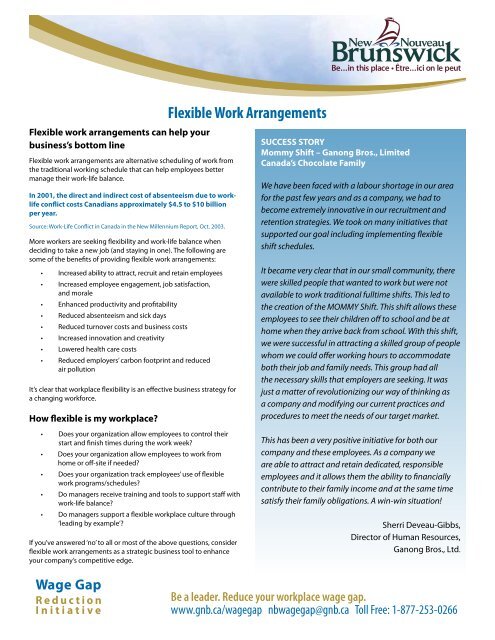Flexible Work Arrangements (PDF)
Flexible Work Arrangements (PDF)
Flexible Work Arrangements (PDF)
Create successful ePaper yourself
Turn your PDF publications into a flip-book with our unique Google optimized e-Paper software.
<strong>Flexible</strong> work arrangements can help your<br />
business’s bottom line<br />
<strong>Flexible</strong> work arrangements are alternative scheduling of work from<br />
the traditional working schedule that can help employees better<br />
manage their work-life balance.<br />
In 2001, the direct and indirect cost of absenteeism due to worklife<br />
conflict costs Canadians approximately $4.5 to $10 billion<br />
per year.<br />
Source: <strong>Work</strong>-Life Conflict in Canada in the New Millennium Report, Oct. 2003.<br />
More workers are seeking flexibility and work-life balance when<br />
deciding to take a new job (and staying in one). The following are<br />
some of the benefits of providing flexible work arrangements:<br />
• Increased ability to attract, recruit and retain employees<br />
• Increased employee engagement, job satisfaction,<br />
and morale<br />
• Enhanced productivity and profitability<br />
• Reduced absenteeism and sick days<br />
• Reduced turnover costs and business costs<br />
• Increased innovation and creativity<br />
• Lowered health care costs<br />
• Reduced employers’ carbon footprint and reduced<br />
air pollution<br />
It’s clear that workplace flexibility is an effective business strategy for<br />
a changing workforce.<br />
How flexible is my workplace?<br />
<strong>Flexible</strong> <strong>Work</strong> <strong>Arrangements</strong><br />
SUCCESS STORY<br />
Mommy Shift – Ganong Bros., Limited<br />
Canada’s Chocolate Family<br />
We have been faced with a labour shortage in our area<br />
for the past few years and as a company, we had to<br />
become extremely innovative in our recruitment and<br />
retention strategies. We took on many initiatives that<br />
supported our goal including implementing flexible<br />
shift schedules.<br />
It became very clear that in our small community, there<br />
were skilled people that wanted to work but were not<br />
available to work traditional fulltime shifts. This led to<br />
the creation of the MOMMY Shift. This shift allows these<br />
employees to see their children off to school and be at<br />
home when they arrive back from school. With this shift,<br />
we were successful in attracting a skilled group of people<br />
whom we could offer working hours to accommodate<br />
both their job and family needs. This group had all<br />
the necessary skills that employers are seeking. It was<br />
just a matter of revolutionizing our way of thinking as<br />
a company and modifying our current practices and<br />
procedures to meet the needs of our target market.<br />
• Does your organization allow employees to control their<br />
start and finish times during the work week?<br />
• Does your organization allow employees to work from<br />
home or off-site if needed?<br />
• Does your organization track employees’ use of flexible<br />
work programs/schedules?<br />
• Do managers receive training and tools to support staff with<br />
work-life balance?<br />
• Do managers support a flexible workplace culture through<br />
‘leading by example’?<br />
If you’ve answered ‘no’ to all or most of the above questions, consider<br />
flexible work arrangements as a strategic business tool to enhance<br />
your company’s competitive edge.<br />
This has been a very positive initiative for both our<br />
company and these employees. As a company we<br />
are able to attract and retain dedicated, responsible<br />
employees and it allows them the ability to financially<br />
contribute to their family income and at the same time<br />
satisfy their family obligations. A win-win situation!<br />
<br />
Sherri Deveau-Gibbs,<br />
Director of Human Resources,<br />
Ganong Bros., Ltd.<br />
Wage Gap<br />
R e d u c t i o n<br />
I n i t i a t i v e<br />
Be a leader. Reduce your workplace wage gap.<br />
www.gnb.ca/wagegap nbwagegap@gnb.ca Toll Free: 1-877-253-0266
<strong>Flexible</strong> work arrangements<br />
Consider some of the following options for flexible work<br />
arrangements to implement:<br />
• flex time / flexible hours<br />
• telework / telecommuting<br />
• compressed workweeks<br />
• job sharing<br />
• part-time / reduced work hours<br />
• phased retirement<br />
• leaves and sabbaticals<br />
• shift work<br />
In 2009, a survey of 286 managers and HR professionals revealed<br />
that 43% of Canadian employers plan to provide flexible work<br />
arrangements in the coming year.<br />
Source: CareerBuilder<br />
Tips for getting started<br />
Beyond just developing flexible work policies and programs,<br />
progressive employers support a flexible workplace culture. Here are<br />
three tips to consider:<br />
• Conduct an employee survey. Every workplace is different.<br />
Get your employees’ input so you can implement flexible<br />
work arrangements that meet the interests and needs of your<br />
employees.<br />
• Educate management and employees. Ensure everyone<br />
understands the benefits and value of flexible work<br />
arrangements. Hold staff meetings to discuss and respond to any<br />
questions. Set clear guidelines and policies.<br />
• Start with a pilot or test trial. Testing out a flexible work<br />
arrangement is an opportunity for both employers and<br />
employees to determine its effectiveness. During this time, you<br />
can evaluate absenteeism, turnover, productivity, etc.<br />
The ability to balance work and personal life is the most critical<br />
factor in employees’ decisions to stay with their jobs according to<br />
a 2008 global survey of nearly 90,000 workers (including 5,000<br />
from Canada).<br />
Source: Towers Perrin<br />
Be informed about flexible work arrangements<br />
Learn more on flexible work arrangements and what other companies<br />
are doing.<br />
• Visit our website www.gnb.ca/wagegap<br />
• Call toll-free 1-877-253-0266<br />
• Email nbwagegap@gnb.ca<br />
Wage Gap<br />
R e d u c t i o n<br />
I n i t i a t i v e<br />
Be a leader. Reduce your workplace wage gap.<br />
www.gnb.ca/wagegap nbwagegap@gnb.ca Toll Free: 1-877-253-0266<br />
CNB 6700 December 2009
















